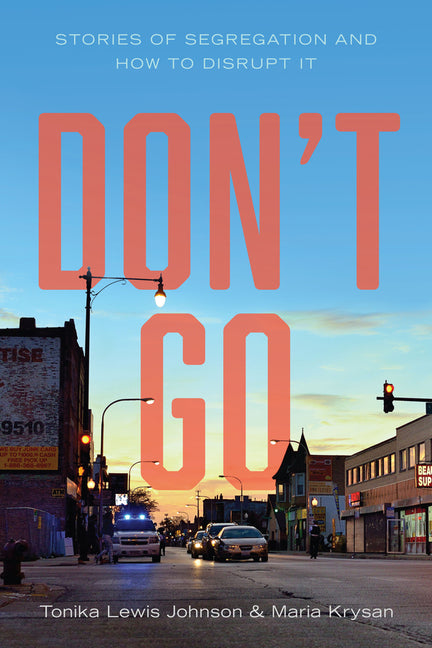Don't Go: Stories of Segregation and How to Disrupt It
Don't Go: Stories of Segregation and How to Disrupt It
Table of Contents:
Foreword - Mary Schmich
What This Book Is About
Tonika's Story
Maria's Story
The Story of "Don't Go" - Tonika + Maria's Story
The Sociologist's Notebook
Section 1: Fear
Grandma's No Go Zone - Adrianne's Story
Adventures of a White Dude - Jerry's Story
Dear Grandma - Jeff's Story
Context is Everything - Aleya's Story
Trains, Robbers, and Coffee - Soren's Story
Fulfilling Prophecies - Danica's Story
Reflections on Stories of Fear
Section 2: Messengers
Let's Get Something on the Books - Joey's Story
Racist Worms - Eva's Story
Following the Pack - Tom's Story
Glitter - Zachary's Story
At the Center of Everything - Katherine's Story
Reflections on the Messengers
Section 3: Shortcuts
What Am I Supposed To Say? - Jenny's Story
Harmful Mundane/Helpful Mundane - Sara's Story
The City Doesn't Eat You Alive - Becky's Story
The Bubbles - Halle's Story
Rent a White Lady - Caroline's Story
Whistling While You Segregate - Jamaine's Story
Reflections on Shortcuts
Section 4: From Hurt to Healing
Accordingly - Leslie's Story
Engineering Change - Tiana's Story
From Mad Max to Lady Dates - Kristine's Story
Curiosity Passports - Roberto's Story
Questions and Answers - Amy's Story
Saying No to Hate - Jenny S's Story
Jumping Rope - Dominic's Story
Reflections on From Hurt to Healing
Section 5: Taking a Step to Take One More
Talking
Feeling
Acting
Biographical Note:
Tonika Lewis Johnson is a photographer and multi-media artist, and creator of the Folded Map Project. She is recipient of the 2024 Gordon Parks Foundation Fellowship and one of Chicago Magazine's 2017 Chicagoans of the Year.
Maria Krysan is LAS Distinguished Professor of Sociology at the University of Illinois Chicago, and co-author of the multiple award-winning book Cycle of Segregation.
Review Quotes:
"Don't Go is a remarkable piece of work that can change how we all live. The human voices and engaging, innovative approach do more than a mountain of data ever could to bridge racial barriers. This is a powerful and compelling book."
Lawrence D. Bobo, Harvard University
"The first-person accounts in this book are a powerful reminder that segregation isn't just about points on a map; it's about the geography of feelings inside those growing up within its shadows. Don't Go lays this bare, while also giving space for hope that change will come - and how."
Henry Louis Gates, Jr., Harvard University
"This book provides a challenging but beautiful reflection on the reality that many Chicagoans know to be true but too often don't know how to talk about or address. In sharing real-life personal accounts, the book invites everyone to consider the power of stories and relationships as a weapon of separation or a tool for healing."
Candace Moore, Senior Strategic Advisor at Race Forward and Inaugural Chief Equity Officer for the City of Chicago
"Don't Go is the much-needed, cross-disciplinary, collaborative tome on how segregation and fear keep cities like Chicago divided. Tonika Lewis Johnson and Maria Krysan frame the complex subject of racism and geography as both a deeply personal narrative and a profoundly systemic problem. As has become Johnson's signature style, in Don't Go she has masterfully blended the poetics of Black life with the very real human emotions - such as uncertainty and misinformation - that keep us all from feeling more connected."
Amanda Williams, Chicago-based artist and 2022 MacArthur Fellow
"Every one of us, no matter how much we're committed to racial justice and believe in racial equality, has stereotypes that we need to overcome. If you think you're immune from the stereotypes of 'dangerous Black neighborhoods, ' you should read this book."
Richard Rothstein, author of The Color of Law
"firsthand accounts provide a fascinating window into the bizarre emotionality of racism ... a deeply revealing examination of the psyche of a city."
Publishers Weekly
Brief Description:
"Multiple times a day, in cities across the US and beyond, a simple yet powerful message is repeated by the well-meaning, the ignorant, and the bigoted: 'don't go' -- avoid at all costs those Black and Brown disinvested neighborhoods that have become bywords for social disorder and urban decay. This book is a collection of stories and photos that uncover the hidden influence of both subtle and overt 'don't go' messages and the segregation they perpetuate in Chicago. Told by everyday people to Tonika Lewis Johnson and Maria Krysan -- a Black artist and a White academic who met through their shared passion for anti-segregation work -- the stories paint a rich picture of life in a segregated city. One by one, the storytellers upend pessimism with candid, deeply personal, humorous, and heartbreaking tales, and with novel ideas for simple actions that can serve as antidotes to both racism and 'place-ism.' By inviting readers into the lives of regular people who have ignored the warning to stay away from 'don't go' neighborhoods or who live in those very same neighborhoods, the stories in Don't Go illuminate the devastating consequences of racial segregation and disinvestment as well as the inevitable rewards of coming together"--
Publisher Marketing:
Multiple times a day, in cities across the US and beyond, a simple yet powerful message is repeated by the well-meaning, the ill-informed, and the bigoted: "don't go" - avoid at all costs those Black and Brown disinvested neighborhoods that have become bywords for social disorder and urban decay.
This book is a collection of intimate stories and evocative photos that uncover the hidden influence of both subtle and overt "don't go" messages and the segregation they perpetuate in Chicago. Told by everyday people to Tonika Lewis Johnson and Maria Krysan - a Black artist and a White academic who met through their shared passion for anti-segregation work - the stories paint a rich picture of life in a segregated city.
One by one, the storytellers upend pessimism with candid, deeply personal, humorous, and heartbreaking tales, and with novel ideas for simple actions that can serve as antidotes to both racism and "place-ism."
By inviting readers into the lives of regular people who have ignored the warning to stay away from "don't go" neighborhoods or who live in those very same neighborhoods, the stories in Don't Go illuminate the devastating consequences of racial segregation and disinvestment as well as the inevitable rewards of coming together.
Product features
Product features
Materials and care
Materials and care
Merchandising tips
Merchandising tips
Share


